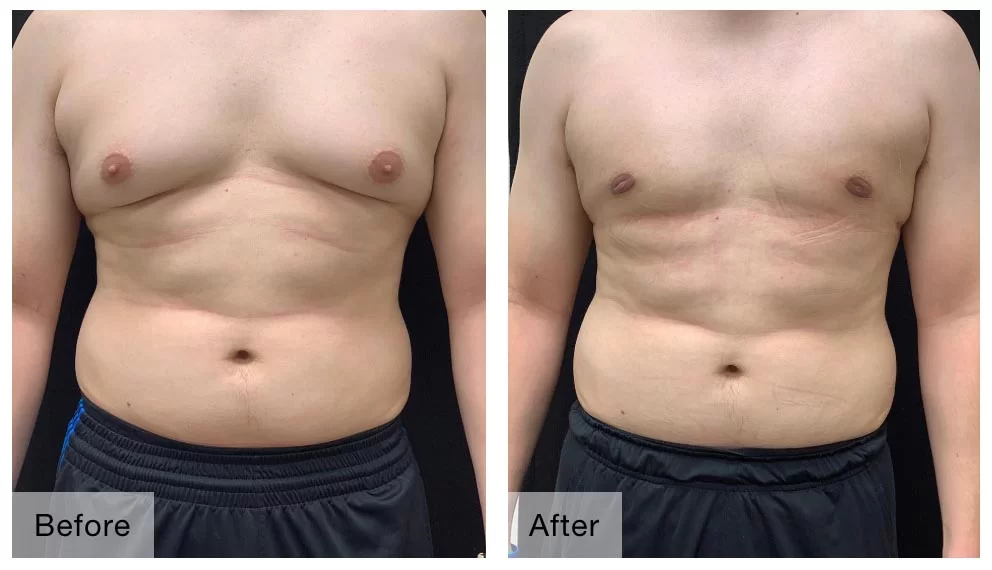Masculine chest contouring, including male breast reduction and cosmetic breast surgery, can transform your appearance and boost your confidence. Many men struggle with body image, feeling trapped in a physique with masculinizing chest features that doesn’t match their identity. This post dives into effective techniques for achieving a sculpted chest, including insights on top surgery incisions for ftm men and plastic options.
From workout routines to dietary tips, for men recovering from chest surgery, we’ll cover everything you need to know about gender. You’ll discover how to enhance your male chest contour and natural shape while embracing your individuality as an example for men and gender. Say goodbye to insecurities and hello to a more defined look, for example, with chest contour for men or neutral chest reconstruction. Whether you’re just starting or looking to refine your approach, this guide is for you. Get ready to redefine what masculinity looks like for you.
Differences Between Top Surgery and Male Chest Contouring
Top Surgery Focus
Top surgery primarily aims to remove breast tissue. Surgeons perform this procedure to help individuals achieve a flatter chest appearance. This is often done through a double incision mastectomy ftm chest surgery. The surgery removes excess skin and fat, creating a more masculine contour.
During the procedure, doctors make incisions on the chest. They take out the breast tissue and excess skin. This results in a significant change in chest shape. Many patients report feeling more comfortable in their bodies after the surgery.
Aesthetic Techniques
Male chest contouring involves more than just removing tissue. It includes aesthetic techniques to enhance the overall appearance of the chest. Liposuction is one method used in this process. It helps to eliminate unwanted fat around the chest area.
Surgeons may also use internal sutures during the procedure. These sutures help create a smoother and more defined look. The goal is to achieve a sculpted chest that aligns with the patient’s vision.
Patients often seek male chest contouring for aesthetic reasons. This option allows for customization based on individual preferences.
Medical Billing Practices
There are important differences in how these procedures are billed. Top surgery is often covered by insurance plans. Many insurance companies recognize it as a medically necessary procedure for transgender individuals.
In contrast, male chest contouring is typically considered cosmetic surgery. Insurance may not cover it because it focuses on enhancing appearance rather than medical necessity. Patients should check with their insurance providers before scheduling the procedure.
Understanding these differences can help individuals make informed decisions about their options.
Goals of Masculinizing Chest Contouring
Natural Appearance
Creating a natural-looking, masculine chest is the primary goal of masculinizing chest contouring. Surgeons aim to remove breast tissue and excess skin. This process helps achieve a flatter and more defined male chest contour.
Proper technique is essential. The surgeon must assess the individual’s body type and desired outcome. A tailored approach ensures the results align with the patient’s expectations.
Nipple Positioning
Another focus is on the reduction and positioning of the nipple and areola. Maintaining proper proportions enhances the overall appearance. The goal is to provide a masculine chest while ensuring that the nipple remains in a natural position.
Surgeons often use specific techniques to reposition the nipple. This can involve resizing or reshaping the areola as well. These adjustments contribute to a more masculinized breast contour.

Scarring Minimization
Minimizing visible scarring is crucial in chest masculinization surgery. Patients prefer a smooth chest contour without noticeable scars. Surgeons strive to eliminate the inframammary fold, which can create an unnatural appearance.
Techniques such as liposuction may be used alongside traditional excision methods. These methods help reduce scarring and improve healing time. Proper incision placement further aids in achieving this goal.
Male Chest Reconstruction Techniques
Various male chest contouring techniques exist for different needs. Some patients may require more extensive procedures, while others might benefit from less invasive options. Each technique has its own advantages.
-
Excision Method: This method involves removing excess breast tissue through incisions.
-
Liposuction: This technique removes fat deposits, creating a flatter appearance.
-
Combination Approach: Many patients find success with a combination of both excision and liposuction.
Surgeons evaluate each case individually to determine the best approach for achieving a masculine chest appearance.
Protocols for Success
Following a structured protocol enhances surgical outcomes. The masculine chest contour protocol includes pre-operative assessments, surgical planning, and post-operative care. Each step is critical for ensuring patient safety and satisfaction.
Surgeons discuss goals with patients prior to surgery. They outline expected results and recovery timelines. Clear communication helps set realistic expectations.
Post-operative care also plays a significant role in recovery. Patients receive instructions on managing pain, swelling, and activity levels after surgery. Adhering to these guidelines promotes optimal healing.
Initial Consultation Preparation
Medical History
Gathering personal medical history is crucial. Surgeons need to know about any past surgeries or medical conditions. This information helps them assess risks and tailor the procedure to each individual. Previous surgical records should also be available for review.
Patients should prepare a list of medications they currently take. This includes prescription drugs, over-the-counter medicines, and supplements. Some medications can affect surgery outcomes. Providing complete details ensures safety during the procedure.
Questions for Surgeon
Preparing questions for the surgeon is essential. Patients should ask about their experience with masculine chest contouring. Knowing how many similar procedures they have performed can build trust.
Inquire about the techniques the surgeon uses. Different methods exist, such as liposuction or tissue removal. Each method has its pros and cons. Understanding these can help patients make informed decisions.
Another important question involves recovery time. Knowing what to expect post-surgery can ease anxiety. Discuss any potential complications that may arise during recovery.
Expectations Discussion
Discussing expectations with the surgeon is vital for achieving desired outcomes. Patients should clearly communicate what they hope to achieve from the surgery. This includes shape, size, and overall appearance of the chest.
Surgeons often provide examples of previous work. These examples can help align patient expectations with reality. It’s important to understand that results may vary based on individual anatomy.
Financial Considerations
Insurance coverage can play a significant role in planning for surgery. Many insurance companies have specific criteria for covering masculine chest contouring procedures. Patients should check with their provider beforehand.
Discuss any charges not covered by insurance during the consultation. Understanding total costs helps in financial planning. Some surgeons offer payment plans, which can ease the burden.
Ideal Candidates
Identifying ideal candidates for masculine chest contouring is necessary during consultations. Individuals should be in good health and have realistic expectations. Age restrictions may apply depending on the surgeon’s policies.
Surgeons will evaluate overall body weight and skin elasticity as well. These factors influence the final results of the procedure.
Necessary Documentation for Surgery
Medical Clearance
Surgeons require medical clearance before proceeding with masculine chest contouring. This step ensures the patient is healthy enough for surgery. Obtaining this clearance involves visiting a primary care physician or a specialist. They assess overall health and any underlying conditions. The physician will review medical history, medications, and allergies. This assessment helps to identify potential risks during surgery.
A thorough evaluation can prevent complications. For instance, individuals with heart issues may need further testing. This could include an EKG or stress test. Surgeons want to ensure that patients are fit for surgical procedures like ftm surgery.
Proof of Insurance
Many surgeons ask for proof of health insurance coverage. This documentation is important for medical billing purposes. It helps determine what costs the insurance will cover. Patients should contact their insurance provider beforehand. They must confirm if the surgery is included in their plan.
e plans may have specific requirements. These can include prior authorization or referrals from a doctor. Understanding these details can save time and reduce unexpected expenses later on.
Pre-operative Forms
Completing pre-operative forms is another crucial step. Surgical facilities require various consent documents before any procedure. These forms outline the risks and benefits of the surgery. They also explain alternative options available to patients.
Patients must read these documents carefully. Understanding what the surgery entails is vital for informed consent. Surgeons often discuss these forms during consultations, ensuring patients have no questions.
Forms may require information about lifestyle habits. This includes smoking, alcohol use, and drug history. Such factors can influence recovery and surgical outcomes.
Surgical Standards
Many surgeons follow established standards for breast surgeries like masculine chest contouring. These standards guide the lengthened incisions and internal sutures used during the procedure. Surgeons aim to minimize complications, such as dog ears or excess skin after healing.
Surgeons typically use drains to manage fluid buildup post-surgery. Proper documentation ensures that all necessary precautions are taken before the operation begins.
Preparing for the Operation
Pre-Operative Instructions
Patients must follow specific pre-operative instructions before undergoing masculine chest contouring. Fasting is often required. Surgeons typically recommend no food or drink for at least six hours before the procedure. Adjustments in medications may also be necessary. Certain blood thinners should be stopped a few days prior to surgery. This helps reduce the risk of excessive bleeding during the operation.
Following these guidelines is crucial for a safe experience. Patients should consult their surgeon about any questions regarding medications. Clear communication ensures proper preparation and minimizes complications.
Transportation Arrangements
Arranging transportation is vital for the day of surgery. Patients cannot drive themselves home after the procedure due to anesthesia effects. Having a trusted friend or family member available is important. They can help with transportation to and from the surgical facility.
Surgeons often advise patients to confirm their ride ahead of time. This avoids last-minute issues that could delay recovery. It’s essential to have someone who can assist during the initial recovery period as well.
Recovery Space Preparation
Creating a comfortable recovery space at home is necessary for post-operative care. Patients should prepare this area with essential supplies. Items like pain medication, ice packs, and clean dressings are important to have on hand.
The recovery space should be quiet and relaxing. Patients may need to rest for several days after surgery. A comfortable bed or couch, along with pillows, can help support healing. Keeping entertainment options nearby, such as books or movies, can also ease boredom during recovery.
Surgeons often provide detailed instructions on post-operative care. Following these guidelines helps ensure a smooth recovery process.
Understanding Costs
Costs for masculine chest contouring can vary widely based on several factors. The type of surgical approach chosen impacts overall expenses. Techniques like liposuction may have different costs compared to more invasive methods. Geographical location plays a role in pricing.
Patients should discuss costs with their surgeon during consultations. Understanding all aspects of pricing helps patients budget effectively for the procedure.
Surgical Techniques
Surgeons use various techniques during masculine chest contouring procedures. The buttonhole technique is one option that some prefer for its minimal scarring potential. Other methods may involve larger incisions but offer different benefits.
Patients should inquire about the specific techniques their surgeon recommends. Each technique has unique advantages and potential drawbacks.
Recovery Expectations After Surgery
Initial Symptoms
Expect initial swelling, bruising, and discomfort in the chest area after masculine chest contouring surgery. These symptoms are normal and part of the healing process. Swelling can last for several weeks. Bruising may appear dark and gradually fade to yellow over time. Pain may also occur but should be manageable with prescribed medication.
Recovery Timeline
Plan for a recovery period of several weeks. Most patients can return to light activities within a week. Strenuous exercise or heavy lifting should be avoided for at least four to six weeks. The body needs time to heal properly. Gradual increases in activity will help avoid complications.
Follow-Up Care
Attend follow-up appointments to monitor healing and discuss any concerns. These visits are crucial for assessing progress. Surgeons will check for signs of infection or complications. Patients should feel comfortable asking questions during these appointments. Open communication is essential for a successful recovery.
Signs of Complications
Watch for any unusual symptoms during recovery. Increased redness, swelling, or discharge from the incision site may signal an issue. Fever or severe pain not relieved by medication requires immediate medical attention. Being aware of these signs helps ensure timely intervention if needed.
Emotional Well-Being
Recovery involves more than just physical healing. Emotional adjustments are also important. Many patients experience anxiety about their appearance during this time. Support from friends, family, or support groups can help ease these feelings. Sharing experiences with others who have undergone similar procedures can provide comfort.
Long-Term Results
The final results of masculine chest contouring become visible over time. Full healing may take several months, but improvements can be seen as swelling decreases. Patients often report increased confidence and satisfaction with their appearance after recovery.
Tips for Smooth Recovery
Follow Instructions
Surgeons provide specific post-operative care instructions. These guidelines are crucial for a successful recovery. Patients must follow them closely to avoid complications. Ignoring these directions can lead to issues like infection or poor healing.
Surgeons often emphasize the importance of rest. Rest allows the body to heal properly after surgery. It is also vital to attend follow-up appointments. These visits help monitor progress and address any concerns.
Wear Compression Garments
Wearing compression garments is essential after chest contouring. These garments support the healing process and reduce swelling. They help keep the treatment area stable during recovery.
Patients should wear these garments as recommended by their surgeon. Typically, they need to be worn for several weeks. This consistent use promotes better results and faster healing.
Compression garments also aid in shaping the chest. They help achieve a smooth and contoured appearance. Many patients find them uncomfortable at first, but they become more tolerable over time.
Avoid Strenuous Activities
Avoiding strenuous activities is critical during recovery. Heavy lifting and vigorous exercise can strain the chest wall. This strain may disrupt the healing process or cause complications.
Surgeons usually recommend resting for a few weeks post-surgery. Patients should wait until they receive clearance from their surgeon before resuming normal activities. This waiting period ensures that the body has healed sufficiently.
Light activities, such as walking, are encouraged after a few days. Walking promotes circulation without putting too much pressure on the chest area.
Manage Pain and Discomfort
Managing pain is an important part of recovery. Surgeons often prescribe medications to control discomfort after surgery. Patients should take these medications as directed.
If pain persists or worsens, contacting the surgeon is crucial. They can provide additional guidance or adjust medications if necessary.
Stay Hydrated and Nourished
Staying hydrated supports overall health during recovery. Drinking plenty of water helps maintain energy levels and aids in healing.
Eating a balanced diet rich in nutrients also plays a role in recovery. Foods high in protein, vitamins, and minerals support tissue repair and overall well-being.
Monitor for Complications
Monitoring for signs of complications is essential after surgery. Patients should watch for symptoms such as increased swelling, redness, or unusual discharge from the surgical site.
If any concerning symptoms arise, contacting the surgeon immediately is necessary. Early intervention can prevent serious issues from developing.
Top Surgery vs. Chest Contouring Outcomes
Aesthetic Results
Top surgery results can vary significantly based on the technique used. Many patients achieve satisfactory results with top surgery alone. However, combining top surgery with male chest contouring can enhance the overall appearance. The addition of chest contouring creates a more defined and masculine chest shape.
Surgeons often use various techniques for top surgery incisions. These include periareolar, double incision, and keyhole methods. Each method impacts the final aesthetic outcome. Patients who opt for chest contouring alongside top surgery frequently report a more sculpted look.
Patient Satisfaction
Patient satisfaction rates are high for both procedures. Studies show that around 90% of patients report being happy with their top surgery results. Feedback often highlights improved self-esteem and body image after the procedure.
Patients who undergo affirming chest reconstruction surgery also express similar satisfaction levels. They appreciate the psychological benefits of achieving their desired chest appearance. Many report feeling more comfortable in their bodies post-surgery.
Common feedback includes appreciation for the natural look achieved through these procedures. Patients often note that their confidence increases significantly after surgery. They feel empowered to wear clothing that reflects their identity.
Importance of Skilled Surgeons
Choosing a skilled surgeon is crucial for achieving desired outcomes in both top surgery and chest contouring. Experienced top surgery surgeons understand the nuances of each technique. They can provide tailored advice based on individual needs.
A qualified surgeon ensures proper planning and execution of the procedure. This attention to detail minimizes complications and enhances aesthetic results. Patients should research potential surgeons thoroughly before making a decision.
Consultations allow patients to discuss goals and expectations openly. Surgeons can evaluate specific body types and recommend appropriate techniques. This personalized approach leads to better results and higher patient satisfaction.
Final Remarks
Masculine chest contouring is a vital step for many seeking to align their physical appearance with their identity. Understanding the differences between top surgery and chest contouring helps you set realistic goals. Preparing for surgery involves documentation, consultations, and recovery expectations. Embracing this journey can lead to significant personal satisfaction and confidence.
Your path to a more masculine chest starts with informed decisions. Make sure to follow the tips provided for a smooth recovery and optimal outcomes. Don’t hesitate to reach out to professionals who can guide you through each step. Your transformation awaits—take action today!
Frequently Asked Questions
What is the difference between top surgery and male chest contouring?
Top surgery typically involves the removal of breast tissue to create a masculine chest, while male chest contouring focuses on shaping the chest for a more defined appearance, often using liposuction or other techniques.
Who is a good candidate for masculine chest contouring?
Ideal candidates are individuals seeking a more masculine chest appearance without significant breast tissue. This procedure suits those who are comfortable with their body and desire aesthetic improvements.
How should I prepare for my initial consultation?
Prepare by gathering medical history, listing medications, and outlining your goals. Be ready to discuss your expectations and any concerns you may have regarding the procedure.
What documentation is necessary for surgery?
Necessary documentation usually includes a referral letter from a mental health professional, medical clearance from your doctor, and any relevant imaging studies if applicable.
What can I expect during recovery after surgery?
Recovery varies but generally includes swelling, bruising, and discomfort. Most patients return to light activities within a week but should avoid strenuous exercise for several weeks.
Are there specific tips for a smooth recovery?
Stay hydrated, follow post-operative care instructions, and attend all follow-up appointments. Avoid smoking and limit alcohol consumption to promote healing.
How do the outcomes of top surgery differ from chest contouring?
Top surgery provides a flatter, more masculine appearance by removing breast tissue. Chest contouring enhances existing contours without significant tissue removal, offering a subtler change in appearance.





